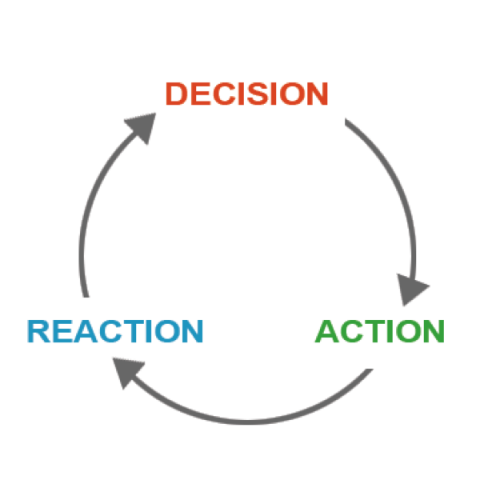Accountability is nothing more than committing to a sequence of actions. Simply follow these 7 steps to improve accountability.
1. Learn From the Past
It’s embarrassing when we fail at something. But failure doesn’t mean a total loss. You pursued a new sport, better education, or even a different hobby. Think about the reasons you set that goal for yourself in the first place. Think of how motivated you were and how hard you pushed yourself. What lessons did you learn? Whether you achieved that goal or not, you should always take something away from it.
When did you last evaluate how you spend every day, week, month, and year?
Where do you look to find inspiration?
What excites you about your life, business, and aspirations?
You should be transparent, even about your failures. Transparency creates and encourages feedback – embrace it. Whether you blog once a week or talk about what you do on social media, you should always be transparent about your experiences.
You are at this exact point in life based on all the choices you made.
“People say nothing is impossible, but I do nothing every day.”A.A. Milne, Winnie the Pooh
2. Find Your Vision and Purpose

Your vision is a roadmap toward your goals. Make it the overarching, big-picture idea in everything you do. It should be well defined and may take some time to figure out. Knowing your purpose can help you decide. Do you know your purpose? Your unique ability (Dan Sullivan book) or your genius discovery shortcut
I wanted to work in a casino onboard cruise ships and took an eight-week course. I practiced my chip-handling skills at night and on weekends. I only applied to work on ships, and even turned down other good jobs whilst I waited. I took a menial, low-paying job while I waited for the position I really wanted. I knew that if I took a good job, it might distract me from finding the job I wanted most. Did it work out? Hell yes! For nine years, I worked on cruise ships. I traveled the world and visited some of the most amazing places on earth. It was worth making the small, short-term sacrifice to help my real dream come true.
3. Set Specific, Measurable Goals
GROW Method
- Goal.
- Current Reality.
- Options (or Obstacles).
- Will (or Way Forward).

- Goal: What are you trying to achieve? Get very specific. It needs to be measurable.
- Reality: How far away are you from achieving what you want?
- Options: What method will you use to track your habits?
- Will: What’s the easiest thing you can do to start your journey and build momentum?
Tools to help measure your habits:
Paper — Good, old-fashioned paper works great. Writing something down has a lasting neurological effect. Writing helps us remember and learn.
Apps — Like Habit Bull, Balanced, Lift, and Way of Life (iOS and Android) can help if you just can’t bring yourself to do any actual writing.It’s best to keep your ideas together in one place. Your chances of failure are directly related to the number of things you have to open, download, or switch between.
4. Develop Healthy Habits
66 Days to Form a Habit
Many people think it takes 30 days to form habits. This misconception comes from Maxwell Maltz’s book Psyco-Cybernetics. He’s actually talking about false memory from losing a limb. It seems it takes less time for the body to give up the memory of a limb than it does to stop an afternoon coffee habit!
5 Minute Journal

The hint is in the name. Take five minutes a day to reflect on what went well, three things you are grateful for, and a brief outline of your identity. This habit is an easy, effective one that you can start right now.
Stop and Start, Keep Method
- What should we Stop doing?
- What should we Start doing?
- What should we Keep doing?
What is a habit?
- Trigger
- Routine
- Reward
5. Get Help, Get Accountable
You need help!
Ask a friend for some help. Or, seek advice from a colleague. Any special group you belong to is a great place to start. Even family members can sometimes offer solid advice–though they should usually be a last resort as they are often too close to you to call you out on your shit. When you set and announce a goal, you are 20 percent more likely to stick to it and achieve it.

Masterminds — Join a mastermind and work on creating mutual accountability. The routine of regular meetings and your commitment to the group will help you stay motivated and increase your chances for success.
One on One — Find someone to help you with your habits and goals. Having similar outlooks and common interests may be helpful. Maybe you both have a bad habit to break. Check in with each other regularly. Support and encourage each other. Make it a routine and priority–or expect to fail.
Create rewards and punishment — Reward yourself for the progress you make. Set financial penalties for yourself if you fail to achieve your goals. You can set your own limits, but make sure to stick to them.
6. Be Honest About Your Accountability
Now that you have an accountability system in place, you need to ensure that it’s working for you. The Covey Institute talks about “A Cadence of Accountability.” It’s the idea that accountability is never a top-down, but a goal that everyone is committed to. Review last week’s commitments; learn from the successes and failures; plan for the following week. Which tasks did you fail to achieve? Why? Were they deemed unimportant, too ambitious, or too time-consuming?
Remember the reasons you set your goals in the first place. It’s vital that you work on these goals first. Do them before you consider addressing any easier, less beneficial tasks. Otherwise, you’ll never achieve your real aspirations.
7. Create a Continuous Loop
(Vision-Action-Habit-Character-Destiny)
You now have the vision, understand your goals, have tools to measure your progress, and understand your habits. Continuing to address these ideas will bring you closer to your vision and help you gain the accountability to keep you on track. As you work on this loop each week, you create a character that has been amplified by the success of the loop. From there, you move towards the destiny that you visioned, set, and implemented for yourself.

Take it Full Circle
Now that you are comfortable with how it works, it’s time to do it all over again. You can add a second, third, or fourth metric to this process. If they are similar habits or tasks, it becomes even easier. You are now primed for success and have the confidence you need to achieve what you really want.
Want a FREE mini-course on how to do all this?
Do you want a mini-course–complete, with free templates–to help you with each step?
Just register HERE for your free access.

